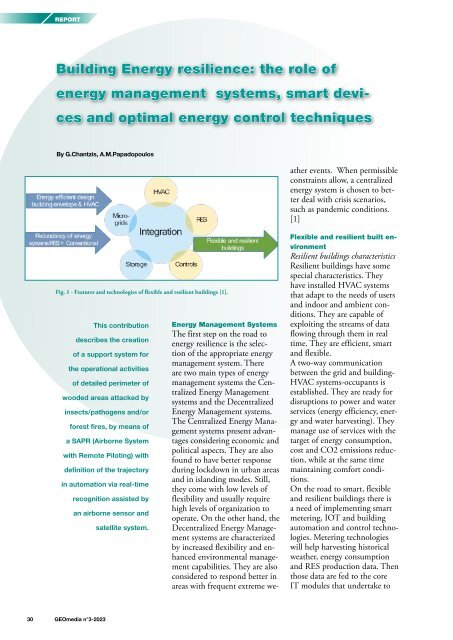GEOmedia_3_2023
EUMAP During the recent pandemic period, the world's attention has shifted towards the healthcare sector, with world leaders striving to avoid the collapse of their national healthcare systems; the economy has entered an artificial coma, while utility systems, including energy, water, telecommunications and waste management systems, have been asked to act immediately in response to these unprecedented conditions, placing extreme pressure on public utility systems.
EUMAP
During the recent pandemic period, the world's attention has shifted towards the healthcare sector, with world leaders striving to avoid the collapse of their national healthcare systems; the economy has entered an artificial coma, while utility systems, including energy, water, telecommunications and waste management systems, have been asked to act immediately in response to these unprecedented conditions, placing extreme pressure on public utility systems.
You also want an ePaper? Increase the reach of your titles
YUMPU automatically turns print PDFs into web optimized ePapers that Google loves.
REPORT<br />
Building Energy resilience: the role of<br />
energy management systems, smart devices<br />
and optimal energy control techniques<br />
By G.Chantzis, A.M.Papadopoulos<br />
Energy Management Systems<br />
The first step on the road to<br />
energy resilience is the selection<br />
of the appropriate energy<br />
management system. There<br />
are two main types of energy<br />
management systems the Centralized<br />
Energy Management<br />
systems and the Decentralized<br />
Energy Management systems.<br />
The Centralized Energy Management<br />
systems present advantages<br />
considering economic and<br />
political aspects. They are also<br />
found to have better response<br />
during lockdown in urban areas<br />
and in islanding modes. Still,<br />
they come with low levels of<br />
flexibility and usually require<br />
high levels of organization to<br />
operate. On the other hand, the<br />
Decentralized Energy Management<br />
systems are characterized<br />
by increased flexibility and enhanced<br />
environmental management<br />
capabilities. They are also<br />
considered to respond better in<br />
areas with frequent extreme weather<br />
events. When permissible<br />
constraints allow, a centralized<br />
energy system is chosen to better<br />
deal with crisis scenarios,<br />
such as pandemic conditions.<br />
[1]<br />
Fig. 1 - Features and technologies of flexible and resilient buildings [1].<br />
This contribution<br />
describes the creation<br />
of a support system for<br />
the operational activities<br />
of detailed perimeter of<br />
wooded areas attacked by<br />
insects/pathogens and/or<br />
forest fires, by means of<br />
a SAPR (Airborne System<br />
with Remote Piloting) with<br />
definition of the trajectory<br />
in automation via real-time<br />
recognition assisted by<br />
an airborne sensor and<br />
satellite system.<br />
Flexible and resilient built environment<br />
Resilient buildings characteristics<br />
Resilient buildings have some<br />
special characteristics. They<br />
have installed HVAC systems<br />
that adapt to the needs of users<br />
and indoor and ambient conditions.<br />
They are capable of<br />
exploiting the streams of data<br />
flowing through them in real<br />
time. They are efficient, smart<br />
and flexible.<br />
A two-way communication<br />
between the grid and building-<br />
HVAC systems-occupants is<br />
established. They are ready for<br />
disruptions to power and water<br />
services (energy efficiency, energy<br />
and water harvesting). They<br />
manage use of services with the<br />
target of energy consumption,<br />
cost and CO2 emissions reduction,<br />
while at the same time<br />
maintaining comfort conditions.<br />
On the road to smart, flexible<br />
and resilient buildings there is<br />
a need of implementing smart<br />
metering, IOT and building<br />
automation and control technologies.<br />
Metering technologies<br />
will help harvesting historical<br />
weather, energy consumption<br />
and RES production data. Then<br />
those data are fed to the core<br />
IT modules that undertake to<br />
30 <strong>GEOmedia</strong> n°3-<strong>2023</strong>

















